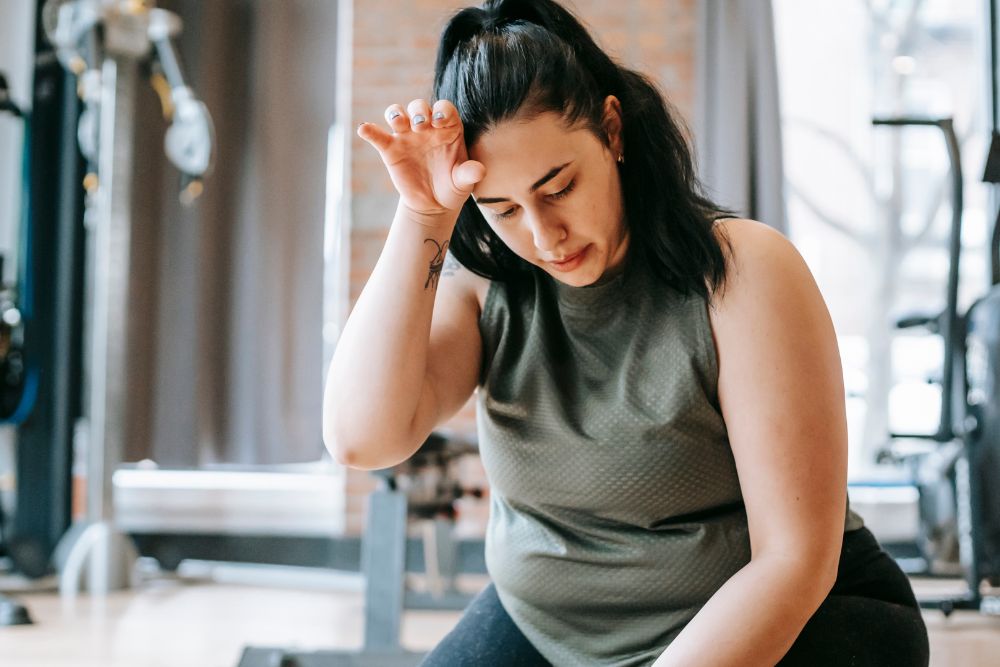Asking, “Does low iron cause weight gain?” is not a simple answer, as the relationship between low iron and weight gain is complex. There are a handful of indirect iron deficiency symptoms that can contribute to weight gain, like activity levels and hormones.
Up to 5% of the Australian population is thought to have iron deficiency anemia. In one study, one in eight people aged two years and over in Australia did not consume enough iron on average to meet their needs.1,2
Many Australians struggle with iron levels, as well as weight gain. Understanding what is happening in your body will make it easier to take the next steps for your health.
Let’s discuss.
Iron’s Vital Role in Your Body

Iron is a vital mineral essential for a wide range of bodily functions. Its most well-known role is in oxygen transport. Red blood cells contain hemoglobin, a protein that relies on iron to bind oxygen and carry it from the lungs to all parts of the body. This oxygen delivery is essential for providing energy to cells and tissues, supporting their function and overall health.3
In addition to hemoglobin, iron is also a component of myoglobin, another protein involved in oxygen transport and storage. Found primarily in muscle cells, myoglobin helps provide the oxygen muscles need to function, particularly during exercise.3 This oxygen is essential for providing energy for daily life. If your body doesn’t have enough iron, your blood can’t carry enough oxygen, which can lead to iron deficiency anemia.4
Beyond oxygen transport, iron plays several other critical roles:
- Enzyme Function: Many enzymes throughout the body rely on iron as a cofactor to function properly. Enzymes act as catalysts, speeding up vital chemical reactions necessary for various biological processes, including energy production and DNA synthesis.3
- Immune System Support: A healthy immune system needs adequate iron to function effectively. Iron is involved in the production and activity of immune cells that help fight off infections and diseases.3
- Thyroid Hormone Production: Iron is important in thyroid hormone synthesis. Thyroid peroxidase, a key enzyme in the production of the thyroid hormones T3 (triiodothyronine) and T4 (thyroxine), requires iron as a component. Thyroid hormones are essential for regulating metabolism, growth, and development. Iron deficiency can impair thyroid peroxidase activity, potentially leading to hypothyroidism, a condition characterised by an underactive thyroid gland.3
- Growth and Development: Adequate iron levels are particularly crucial during periods of rapid growth and development, such as infancy, childhood, and pregnancy. Iron contributes to cell growth and division, DNA synthesis, and the production of red blood cells, all essential processes during these life stages.3
The recommended dietary intake of iron varies depending on age, sex, and life stage. Specific groups are at higher risk of iron deficiency, including:
- Infants and Toddlers: Especially those who drink cow’s milk.5
- Teenage Girls: Due to menstrual blood loss and increased iron needs for growth.5
- Menstruating Women: Particularly those with heavy periods.5
- Pregnant Women: Due to increased iron demands for fetal development.5
- People with Poor Diets: Including those with eating disorders or who follow restrictive diets.5
- Vegetarians and Vegans: Who may not consume enough heme iron, which is more easily absorbed by the body than non-heme iron.5
- Athletes in Training: Due to increased iron needs from muscle mass expansion and endurance activities.5
- People with Certain Medical Conditions: That affect iron absorption or lead to blood loss, such as celiac disease, gastrointestinal disorders, or chronic diseases.5
While iron is essential, too much iron can also be harmful. Individuals with hemochromatosis, a genetic condition that causes excessive iron absorption, are at risk of iron overload. Excess iron can damage organs, potentially leading to serious problems like liver cirrhosis, liver cancer, and heart disease.6
It’s important to note that the information provided is intended for general knowledge and should not be interpreted as medical advice. It is essential to consult a healthcare professional for personalised guidance regarding iron intake, testing, or treatment for any health concerns.7
Symptoms of Low Iron

- General Weakness and Lethargy: This is a very common symptom of low iron levels, especially when it progresses to iron deficiency anemia. This fatigue stems from the body’s reduced capacity to produce hemoglobin, the protein in red blood cells responsible for transporting oxygen from the lungs to the rest of the body. Without enough iron, your body cannot produce enough hemoglobin to meet its needs, leading to feelings of tiredness and weakness.8
- Gastrointestinal Issues: Several gastrointestinal symptoms are associated with low iron, though the specific issues and their underlying causes can differ:
- Iron Deficiency Anemia: In this case, a gastrointestinal upset might occur due to the body struggling to absorb enough iron from food. This can lead to symptoms such as abdominal pain, nausea, and changes in bowel habits.3
- Iron Overload: Conditions like hemochromatosis, characterised by excessive iron absorption, can also cause gastrointestinal problems, but these are usually due to organ damage from long-term iron buildup.6
- Iron Supplements: Taking high doses of iron supplements, particularly on an empty stomach, can irritate the digestive system, leading to an upset stomach, constipation, nausea, abdominal pain, vomiting, and diarrhea.9
- Pale Skin (Pallor): This is another common sign of iron deficiency anemia. The paleness occurs because hemoglobin gives blood its red color. When iron levels are low, hemoglobin production decreases, resulting in less vibrant red blood circulating through the skin, making it appear paler than usual.8
- Shortness of Breath: Iron deficiency anemia can cause shortness of breath because the blood struggles to deliver enough oxygen to the body’s cells and tissues. This symptom might be particularly noticeable during physical activity when the demand for oxygen increases.8
- Cognitive Impairment: Iron plays a critical role in brain function. Low iron levels can impair cognitive abilities, including concentration, focus, and memory. This might manifest as difficulty staying attentive, brain fog, or trouble remembering things.10
- Restless Legs Syndrome: Some studies suggest a link between iron deficiency and restless legs syndrome. This condition causes an irresistible urge to move the legs, often accompanied by uncomfortable sensations.11
- Hair Loss: Iron deficiency can contribute to hair loss because hair follicles, like other cells in the body, require iron for growth and repair.12
- Hypothyroidism: Iron is crucial for producing thyroid hormones. When iron levels are low, the thyroid gland may not function optimally, potentially leading to hypothyroidism, a condition characterised by an underactive thyroid gland. Symptoms of hypothyroidism can include fatigue, weight gain, cold intolerance, and dry skin.13
- Changes in the Tongue and Nails: Iron deficiency anemia can lead to:
- Smooth Tongue: This occurs when the tiny bumps on the tongue (papillae) shrink or disappear.12
- Brittle Nails: Iron deficiency can also affect the health and strength of your nails, making them prone to breakage.12
- Pica: This is a condition characterised by cravings for and consumption of non-nutritive substances, such as ice, dirt, or paper. Pica is more common in children and pregnant women and can be a sign of iron deficiency.3
- Joint Pain: While not directly caused by low iron levels, joint pain, particularly in the second and middle fingers, is a possible symptom of later-stage hemochromatosis. This condition involves the body absorbing too much iron from food, leading to iron buildup and potential organ damage, including joint problems.6
In addition to the above, children with iron deficiency anemia may experience behavioural problems, loss of appetite, increased sweating, and failure to grow at the expected rate.12
It is essential to reiterate that many of these symptoms can also be caused by other medical conditions. Therefore, it is crucial to consult a healthcare professional for proper diagnosis and treatment if you are experiencing any of these symptoms. Self-treating low iron or related conditions can be harmful.14
What Causes Low Iron?
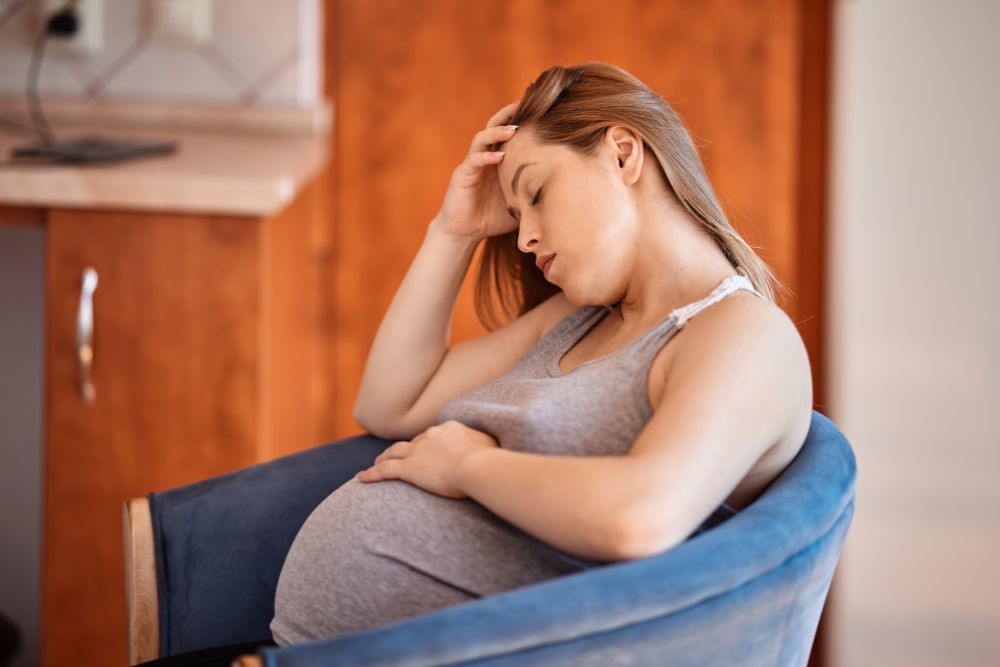
- Inadequate dietary iron intake is a primary cause, particularly among vegetarians and vegans, those on restrictive diets, and infants, children, pregnant women, and breastfeeding women. Plant-based diets often lack heme iron, which is more readily absorbed than non-heme iron.1,3
- Chronic blood loss is another significant contributor to low iron. Heavy menstrual periods, gastrointestinal bleeding (often difficult to detect without specific tests), regular blood donation, and bleeding conditions like nosebleeds or gum disease can lead to iron loss. Certain medications, such as aspirin, can also increase bleeding risk.1,3
- Malabsorption occurs when the body struggles to absorb iron effectively, even with sufficient intake. Celiac disease, inflammatory bowel disease, and surgeries like bariatric surgery can hinder absorption.1,3
- Increased demand during pregnancy, growth spurts, and intense physical activity can also contribute to low iron if intake doesn’t match the body’s needs.1,3
- Malaria: This parasitic infection destroys red blood cells (hemolysis), leading to iron loss through urine. It can also suppress erythropoietin, a hormone crucial for red blood cell production, and increase hepcidin, a hormone that regulates iron absorption.15
- Hookworm Infection: This intestinal parasite, often found alongside malaria in tropical regions, causes blood loss from the gut.15,16
What are Ferritin Levels?
Ferritin is a protein that stores iron inside your cells for later use. Ferritin levels in your blood can be measured with a blood test. These levels provide crucial information about your body’s iron stores.7 Serum ferritin is a valuable clinical tool, particularly in assessing and managing conditions related to iron deficiency and iron overload.7 Doctors often order a serum ferritin test as part of a panel of blood tests to diagnose and monitor these conditions.7
Let’s examine how ferritin levels relate to both iron deficiency and iron overload:
- Iron Deficiency: A low serum ferritin level is a strong indicator of iron deficiency anemia. Serum ferritin is a more reliable measure of iron deficiency than other blood tests like red cell protoporphyrin, transferrin saturation, mean cell volume, or red cell distribution width.17
- While normal ferritin levels vary between labs, a serum ferritin level below 12 ng/ml is generally considered indicative of depleted iron stores.17
- It is important to note that certain conditions like hypothyroidism and ascorbate deficiency can also lower serum ferritin levels.17
- Iron Overload: Elevated ferritin levels can be associated with conditions like hemochromatosis, where the body absorbs too much iron from food.6 However, high ferritin levels don’t always signal readily available iron for the body to use. For instance, people with chronic kidney disease often exhibit high serum ferritin, but this doesn’t necessarily reflect usable iron stores.7
- Inflammation from various causes, including chronic diseases, infections, or trauma, can also significantly elevate ferritin levels. This increase often doesn’t correspond to actual increases in usable iron and can be misleading when interpreting ferritin levels alone.7
Importantly, a single ferritin level might not provide a complete picture of your iron status, especially if other health conditions are present. To obtain a comprehensive understanding of your iron levels and address any potential deficiencies or excesses, consult a healthcare professional for personalised advice and treatment.7
Difference Between Iron and Ferritin
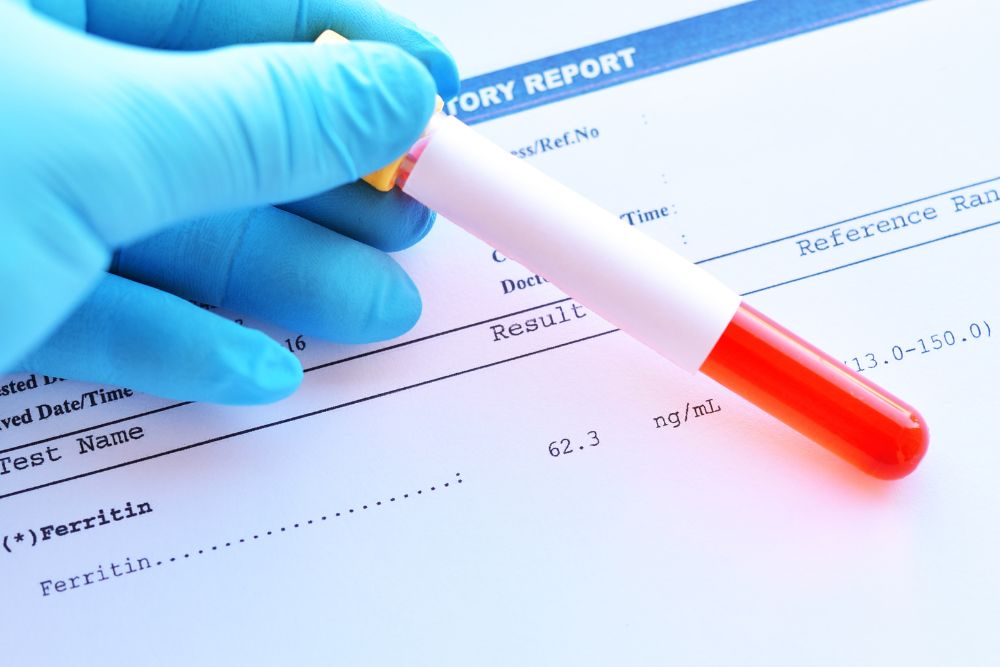
Iron is a mineral that plays a vital role in various bodily functions.3 You obtain iron through your diet, with foods like lean meat, seafood, poultry, fortified cereals, beans, lentils, and some nuts and dried fruits being good sources.3 Iron exists in two forms in food: heme iron (found in animal products) and nonheme iron (found in plant-based foods).3
Ferritin, on the other hand, is a protein that stores iron within your cells, releasing it when your body needs it.7 It acts as your body’s internal iron reserve, ensuring that iron is available when required for various metabolic processes.7
Here’s a table summarising the key differences:
Feature | Iron | Ferritin |
Category | Mineral | Protein |
Primary Role | Functional | Storage |
Source | Diet | Produced by the body |
Think of iron as a crucial ingredient your body needs, and ferritin as the storage container for that ingredient.7 In essence, while both iron and ferritin are integral to maintaining healthy iron balance in the body, they represent different aspects of this intricate system. Iron is the essential worker, actively involved in various biological processes, while ferritin acts as the careful warehouse manager, ensuring a reserve of iron is available when needed.7
Can I Have High Ferritin Levels but Low Iron?
Ferritin levels in your blood, measured through a blood test, serve as an indicator of your body’s iron stores.7 Low ferritin levels often suggest iron deficiency anemia, while elevated levels can indicate iron overload or other conditions like inflammation.7
However, high ferritin levels don’t always equate to sufficient usable iron in the body. Inflammation and certain diseases can elevate ferritin levels without reflecting actual iron stores.7 A combination of tests is necessary to accurately assess iron status, especially in the presence of inflammation or chronic illness.7
Here’s why:
- Ferritin as an Acute Phase Reactant: Ferritin, while primarily an iron storage protein, is also considered an acute phase reactant. This means that its levels in the blood can increase significantly in response to inflammation, infection, and certain chronic diseases.7
- Misleading Ferritin Levels: In these situations, a high ferritin level may not accurately reflect true iron stores. The body, in an attempt to limit iron availability to potential pathogens, increases ferritin production, effectively “locking away” iron.7
- Functional Iron Deficiency: This phenomenon is known as functional iron deficiency, where iron is present within the body but not readily accessible for essential functions like red blood cell production.7
- Ferritin and Chronic Kidney Disease: Patients with chronic kidney disease often exhibit high serum ferritin levels, yet they may still experience iron deficiency because the stored iron isn’t bioavailable.7
- The Importance of Additional Testing: Therefore, relying solely on ferritin levels for diagnosing iron deficiency, especially in individuals with underlying inflammatory or chronic conditions, can be misleading. Doctors often consider other blood tests, like transferrin saturation and the transferrin receptor-ferritin index (TfR-F), for a more comprehensive evaluation of iron status.7
Strategies to Increase Iron Levels
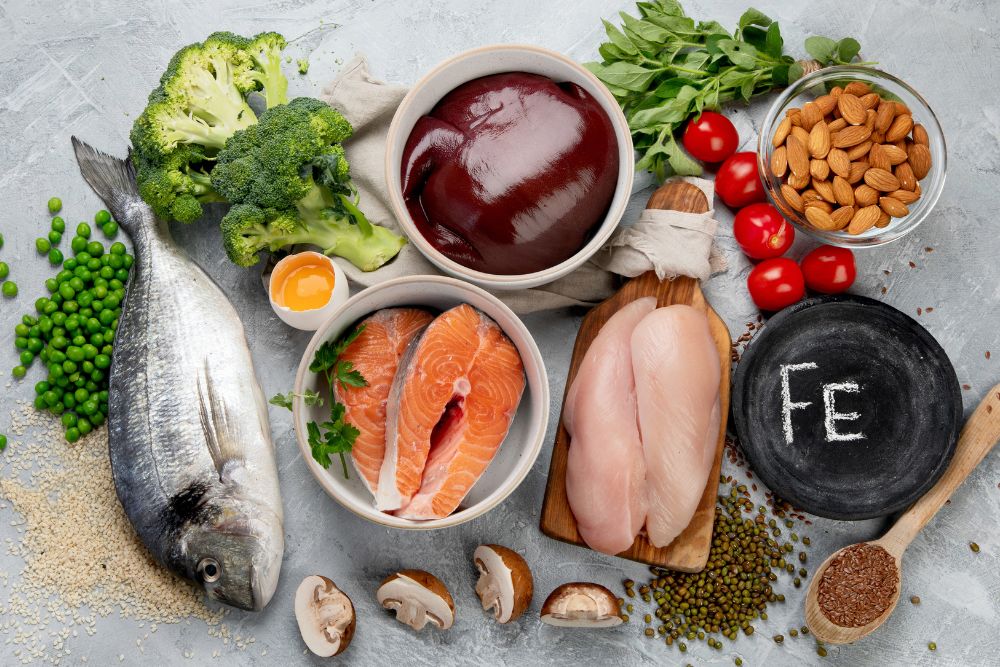
Dietary Interventions:
- Consume Iron-Rich Foods: It is important to have a balanced diet rich in iron. Include foods like:
- Heme Iron Sources (better absorbed): Lean meat (beef, lamb, kangaroo), offal (liver, kidney – pregnant women should consume these in moderation due to high vitamin A content), poultry (chicken), and fish.3
- Non-heme Iron Sources: Iron-fortified breakfast cereals and breads, white beans, lentils, spinach, kidney beans, peas, nuts, dried fruits (raisins, prunes, dried apricots), seeds.3
- Enhance Iron Absorption:
- Pair with Vitamin C: Consume iron-rich foods alongside those high in vitamin C, like citrus fruits, strawberries, sweet peppers, tomatoes, and broccoli. This enhances non-heme iron absorption.3
- Combine Heme and Non-Heme Sources: Eating meat, poultry, or seafood with plant-based iron sources improves the absorption of iron from plant foods. For example, have beef and kidney beans in chili con carne.3
- Cook Plant-Based Iron Sources: Cooking generally increases the amount of non-heme iron your body can absorb from vegetables.3
- Be Mindful of Absorption Inhibitors:
- Limit Tea, Coffee, and Wine Consumption with Meals: Tannins in these beverages can hinder iron absorption by binding to it.3
- Moderate Soy Protein Intake: Soy proteins may reduce iron absorption from plant sources.3
- Manage Phytate and Fiber Consumption: While important for overall health, phytates and fibres in whole grains like bran can slightly reduce iron absorption.3
- Ensure Adequate Vitamin A: Vitamin A helps release stored iron. An inadequate intake could contribute to iron deficiency.3
- Separate Calcium and Iron Intake: High calcium intake can interfere with iron absorption, especially from non-heme sources. Space out the consumption of dairy products and iron-rich foods.3
Iron Supplements:
- Consult a Healthcare Professional: Do not self-diagnose or self-medicate with iron supplements. Over-the-counter iron supplements are available, but it’s crucial to consult a doctor to determine if you have a deficiency and require supplementation.7
- Dosage and Duration: Your doctor will advise on the appropriate dosage and duration of iron supplementation based on your individual needs.7
- Empty Stomach and Potential Side Effects: Iron supplements are generally best absorbed on an empty stomach. However, they can cause side effects like dark stools, nausea, vomiting, constipation, or diarrhea. Inform your doctor if these occur, as they might recommend adjusting the dosage.9
Address Underlying Causes:
- Blood Loss: Chronic blood loss is a significant contributor to iron deficiency. This could be due to heavy menstrual periods, regular blood donation, gastrointestinal bleeding (ulcers, polyps, cancers), or certain medications like aspirin. Identifying and addressing the root cause of blood loss is essential for long-term iron level management.3
- Malabsorption: Certain conditions, like celiac disease, can impair iron absorption from the gut. If you suspect malabsorption, consult your doctor for diagnosis and appropriate management.3
Other Considerations:
- Infants and Children: Babies’ iron stores primarily come from the mother during pregnancy. Breastfeeding or using iron-fortified infant formulas is crucial for infants. Introducing iron-rich solid foods around six months of age is also important. Toddlers and young children should consume lean red meat a few times a week, along with other iron-rich foods and vitamin C sources.3
- Teenagers: Adolescent girls are particularly susceptible to iron deficiency due to growth spurts, menstruation, and potential dietary restrictions. Encouraging iron-rich foods, vitamin C intake, and moderate consumption of tea and coffee can help maintain iron levels.3
- Pregnant Women: The body’s demand for iron increases significantly during pregnancy to support the growing fetus. Doctors often recommend iron supplements for pregnant women.3
- Athletes: Intense physical activity increases iron requirements. Athletes should ensure their diet provides adequate iron from both heme and non-heme sources.3
It’s essential to reiterate that while the information provided offers a general overview, consulting a healthcare professional for personalised advice on increasing your iron levels is paramount. They can assess your specific situation, conduct necessary tests, and recommend the most appropriate course of action.7
How Do Iron Levels Affect Your Weight?
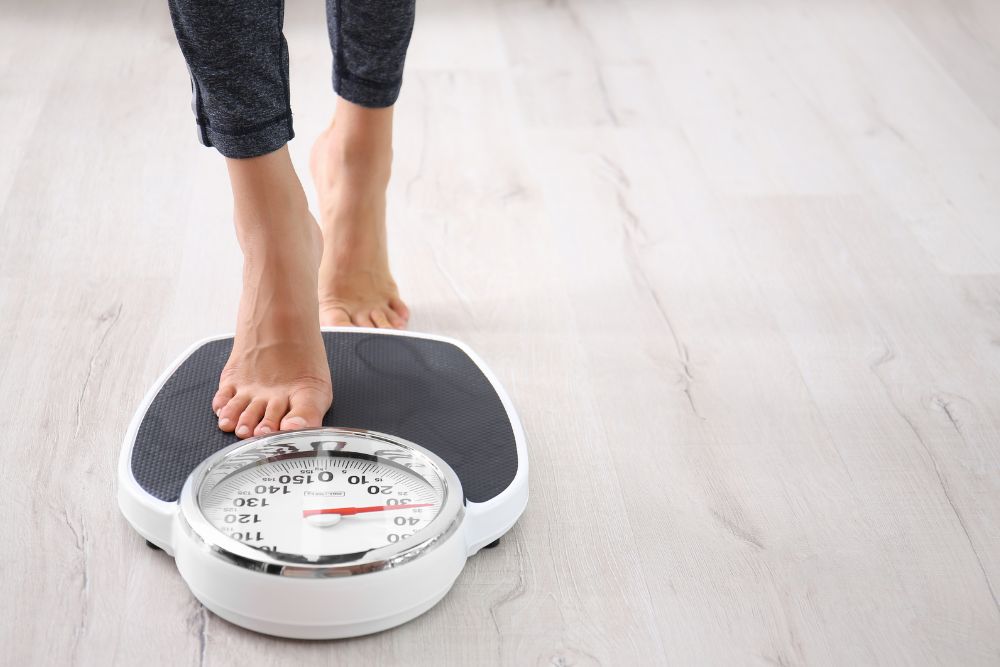
- Iron Deficiency Anemia and Metabolism: When the body is deficient in iron and, consequently, hemoglobin, this can lead to a slowed metabolism. A slower metabolism means the body burns calories less efficiently, which could theoretically contribute to weight gain.7
- Iron Deficiency Anemia and Thyroid Function: Iron deficiency can impair thyroid hormone production. One study found that iron-deficient adolescent girls improved some thyroid hormone levels after receiving iron supplementation. Thyroid hormones play a significant role in regulating metabolism.3,13
- Hypothyroidism, a condition characterised by an underactive thyroid gland, can lead to weight gain. While there isn’t a direct causal link between iron deficiency anemia, hypothyroidism, and weight gain, there is a potential interplay between these factors.13
- Iron Deficiency Anemia and Fatigue: Iron deficiency anemia often leads to fatigue and weakness, making it difficult to engage in physical activity. This lack of energy could indirectly contribute to weight gain by reducing calorie expenditure.7
- One study found that treating iron deficiency anemia in women led to weight loss. However, this study was relatively small, and more research is needed to confirm these findings.7
Can Increasing Iron Help You Lose Weight?
Iron deficiency anemia often causes fatigue and weakness, making it difficult to be physically active. Improving your iron levels, therefore can help you feel more energised and physically active, leading to more calories burnt.7
Iron deficiency can impair thyroid hormone production, which is crucial for regulating metabolism. One study mentioned that iron supplementation improved thyroid hormone levels in iron-deficient adolescent girls. Since an underactive thyroid (hypothyroidism) can lead to weight gain, this suggests a possible link between iron, thyroid function, and weight. However, more research is needed to determine if correcting iron deficiency alone would be sufficient to influence weight.3,13
Everyone’s body is different. There are many other factors that can cause you to lose or gain weight. Taking iron supplements or getting iron infusions should not be used as a weight loss tool.7
Ways To Lose Weight
People’s weight changes over the course of their lives. Wanting to lose weight can be difficult with an iron deficiency. Opting for weight loss solutions like weight loss injections, weight loss medications, or low-calorie diets can be helpful to support your weight loss journey.
It’s essential to consult a healthcare professional for personalised advice on increasing your iron level and weight loss journey. They can assess your specific situation, conduct necessary tests, and recommend the most appropriate course of action.
References
- Better Health Channel. Iron. https://www.betterhealth.vic.gov.au/health/conditionsandtreatments/iron
- Australian Bureau of Statistics. Australian Health Survey: Usual Nutrient Intakes. https://www.abs.gov.au/statistics/health/health-conditions-and-risks/australian-health-survey-usual-nutrient-intakes/latest-release
- Healthdirect. Vitamins and Minerals. https://www.healthdirect.gov.au/vitamins-and-minerals
- KidsHealth. Iron. https://kidshealth.org/en/parents/iron.html
- National Institutes of Health. Iron Consumer. https://ods.od.nih.gov/factsheets/Iron-Consumer/
- Better Health Channel. Haemochromatosis. https://www.betterhealth.vic.gov.au/health/conditionsandtreatments/haemochromatosis
- Mayo Clinic. Ferritin Test. https://www.mayoclinic.org/tests-procedures/ferritin-test/about/pac-20384928
- Mount Sinai. Ferritin Blood Test. https://www.mountsinai.org/health-library/tests/ferritin-blood-test
- Tang AM, Chung M, Dong K, et al. Iron deficiency anemia: a challenge to identify. Nutrients. 2017;9(1):36. https://www.ncbi.nlm.nih.gov/pmc/articles/PMC6166193/
- Beard JL. Iron biology in immune function, muscle metabolism and neuronal functioning. J Nutr. 2001;131(2S-2):568S-579S. https://www.ncbi.nlm.nih.gov/pmc/articles/PMC2893236/
- Allen RP, Auerbach S, Bahrain H, Auerbach M, Earley CJ. The prevalence and impact of restless legs syndrome on patients with iron deficiency anemia. Am J Hematol. 2013;88(4):261-264. https://www.ncbi.nlm.nih.gov/pmc/articles/PMC4504597
- Robinson S, Cooper C. Hair and nail changes in patients with iron deficiency. Br J Haematol. 2007;136(2):212-217. https://www.ncbi.nlm.nih.gov/pmc/articles/PMC6166193/
- Zimmermann MB, Kohrle J. The impact of iron and selenium deficiencies on iodine and thyroid metabolism: biochemistry and relevance to public health. Thyroid. 2002;12(10):867-878. https://www.ncbi.nlm.nih.gov/pmc/articles/PMC6166193/
- Pennell DJ, Udelson JE, Arai AE, et al. Cardiovascular function and treatment in beta-thalassemia major: a consensus statement from the American Heart Association. Circulation. 2013;128(3):281-308. https://www.ncbi.nlm.nih.gov/pmc/articles/PMC2893236/
- Lalloo DG, Olukoya P, Olliaro P, et al. Treatment of uncomplicated malaria. In: Gazzinelli RT, ed. World Health Organization (WHO). Treatment Guidelines. Geneva, Switzerland: WHO; 2011:144-175. https://www.ncbi.nlm.nih.gov/pmc/articles/PMC6166193/
- Hotez PJ, Brooker S, Bethony JM, Bottazzi ME, Loukas A, Xiao S. Hookworm infection. N Engl J Med. 2004;351(8):799-807. https://www.ncbi.nlm.nih.gov/pmc/articles/PMC6166193/
- World Health Organization (WHO). Assessing the iron status of populations: report of a joint World Health Organization/Centers for Disease Control and Prevention technical consultation on the assessment of iron status at the population level. 2nd ed. Geneva, Switzerland: WHO; 2007. https://www.ncbi.nlm.nih.gov/pmc/articles/PMC6166193/


